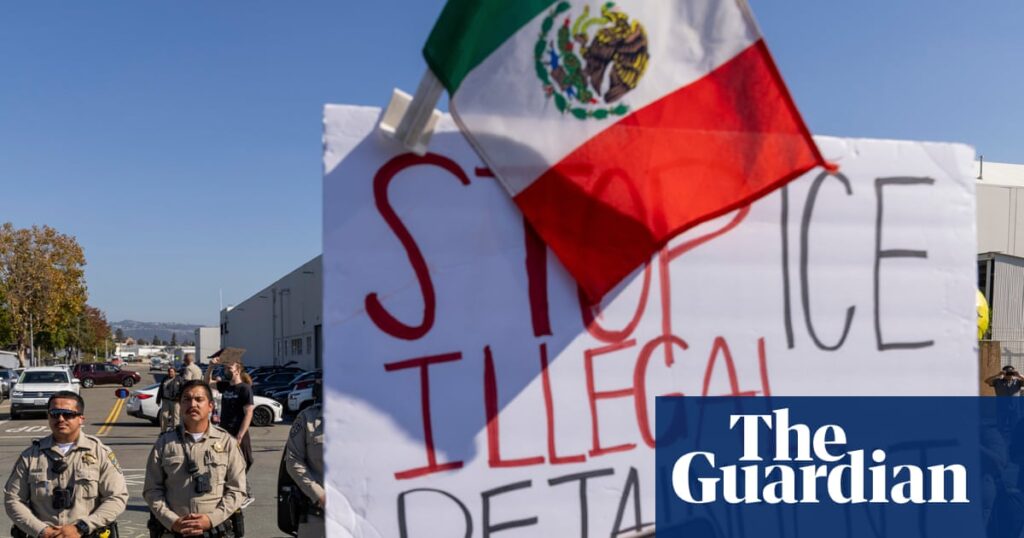
In a whirlwind of anticipation and anxiety, the San Francisco Bay Area found itself on high alert as local leaders and community organizers prepared for a possible large-scale immigration enforcement operation. The tension peaked on Thursday, only to be partially alleviated by former President Donald Trump’s unexpected announcement to call off the federal “surge,” leaving residents in a state of uneasy anticipation.
Trump’s decision to halt the operation was delivered via a mid-morning announcement, advising residents to “stay tuned” for future developments. Despite this temporary reprieve, many Bay Area residents continued their preparations for potential enforcement actions. Volunteers organized patrols in areas frequented by day laborers and initiated programs to assist the children of undocumented workers in commuting to school. Demonstrations erupted across the region, with hundreds gathering in San Francisco and Oakland.
Community Mobilization and Local Leadership
Jose Ramirez, a 59-year-old resident of the predominantly Latino community of Fruitvale in east Oakland, voiced the sentiments of many locals. “I think he’s just trying to mess with us, with our Bay Area,” he said, standing among hundreds of supporters. “But we’re still out here to support.”
Oakland Mayor Barbara Lee addressed the media, confirming reports of Customs and Border Protection agents stationed at the local U.S. Coast Guard base. “The federal administration, of course, has escalated its rhetoric and its enforcement posture in the Bay Area,” she stated. “But let me be clear, [in] our city, as I said, we are fully prepared.”
By Thursday evening, uncertainty lingered over whether Immigration and Customs Enforcement (ICE) and Customs and Border Protection (CBP) agents would proceed with increased enforcement in cities like Oakland. The Department of Homeland Security did not respond to inquiries, instead referencing Trump’s social media post, which cited a conversation with tech leaders, including Salesforce CEO Marc Benioff, as influential in his decision to call off the operation.
Tech Industry’s Role and Community Response
Local officials and advocates expressed strong disapproval of Silicon Valley billionaires, including Benioff, who had previously suggested deploying national guard troops to the city. San Francisco City Supervisor Jackie Fielder criticized the tech moguls from the steps of city hall, with the Salesforce tower looming in the background. “We are here because Benioff of Salesforce put forth this idea,” she declared.
In response, community groups in Fielder’s district prepared to counter any potential raids. The non-profit Homies Organizing the Mission to Empower Youth (Homey) had already been conducting street patrols to monitor ICE activity. “The patrols are also to build community, to make sure that people know their rights,” said José Luis Pavón, an organizer with the group. “I feel like people are starting to lose their fear. People are getting a lot more practical.”
Bay Resistance, a social justice non-profit, pledged to continue sending volunteers to locations where day laborers gather, such as Home Depot stores, to monitor for immigration agents and educate workers about their legal rights. The Latino Task Force committed to transporting students of undocumented parents to schools across the city.
Community Resilience and Forward Planning
Lisa Knox, co-executive director of the California Collaborative for Immigrant Justice, emphasized the community’s preparedness. “We always say ‘power, not panic,’” Knox stated. “We’re focused on getting the message out to the community that they are not alone, people have rights if they encounter ICE or federal agents, and there are rapid response networks that can provide support if they are arrested.”
Knox highlighted that the president’s announcement did not alter their plans. “We’re not taking Trump at his word. He’s equivocated before. We’re sticking with our plans,” she added.
In Fruitvale, the impact of the looming threat was palpable. Street vendors reported a significant drop in foot traffic, and the usually bustling farmers market was notably subdued. Rosemary, an 18-year-old community college student, joined the protest, expressing concern over the fear gripping her community. “We cannot let this happen – where people are afraid to get out of the house, where people are afraid to be seen,” she said.
Jaime, an English language development teacher, joined the protests to show solidarity with her students and their families, many of whom are immigrants. Teachers hosted a brown bag lunch for students worried about federal actions, strategizing fundraisers for affected families and reviewing legal rights information.
Historical Context and Future Implications
As night fell over the Bay Area, protesters marched from Fruitvale toward the Coast Guard base, a symbolic gesture of resistance and solidarity. Gabriela DelaRiva, a retired nurse and lifelong activist, reflected on her family’s immigrant history and the ongoing struggle for immigrant rights. “To see progress, and then to see these things going backwards, it’s very distressing, very painful,” she said. “But I’m so proud to be in the Bay Area where people do get activated.”
The Bay Area’s response to the potential crackdown highlights a broader narrative of resilience and community solidarity in the face of federal immigration policies. As the region braces for what may come next, its residents remain vigilant, prepared to defend their rights and support their neighbors.





